On many occasions where systems get upgraded older parts get left over. These are either traded ,binned or reused for other purposes. Now if you're like me, you'll want to find a new purpose for every old parts left. When a friend of mine asked me to upgrade his old Dell computer i inherited his old 'beast' of a videocard. Here are some specs of the 'beast': Core: RV370 @ 400mhz Mem: 128MB DDR @ 250(500)mhz  Dell's near identical X600XT version (which isn't XT at all) It was only used for the memory, but i never quite understood LM324 setups, so this time it just offended me. Got me angry in the right kind of way. "This time i will properly mod an LM324 and understand the principal workings so i can do it again someday!" Also i didn't want to ruin the silent experience i was enjoying from this card so i decided it would need better cooling if i was to increase the voltages. Luckily i didn't bin parts that did not get new purposes right away ;)Whenever you are overclocking something you will generate more heat which will need to be removed from the source as quickly as possible. Usually a bigger fan or a bigger heatsink will do and in extreme cases water. I wasn't aiming for anything extreme here but i didn't want to resort to any screaming fans so a bigger heatsink would be needed. Also the memory would probably get hot under load so better address this too. Here is how the card looks after the modifications: 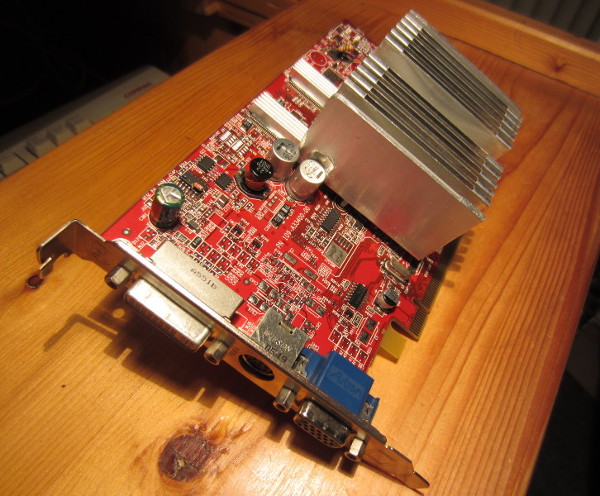 If you're not the DIY type you can of course always resort to the after market solutions. Memory Voltage As mentioned the memory voltage is governed by the LM324 chip. Usually we he have a plain voltage regulator or a PWM to deal with, which are easily modified using the FB pin or in case of a regulator the ADJUST pin. An LM324 circuit is not that different from a voltage regulator but without any protection circuits and much less elegant. They are usually quite clumsy to measure, additionally it has 4 channels which in effect are 4 independent regulators. The LM324 pinout Now you can see the 4 op-amps inside the LM324. 'As is' the LM324 has nowhere near enough power to run all those DDR chips on it's own, that's why they are always coupled to an output transistor which increases the output power.  A simple regulator with increased power trough Q1 Now notice the feedback line to the LM324, this is what were looking for! However an important note has to made here, the polarity of the output transistor determines if the feedback is negative or positive. This means that the feedback could either end up on the negative or positive input of the LM324, this got me quite confused in the past. Usually though you will find it at the negative input. The Dell Radeon card uses two 6680AS smd MOSFET transistors in conjunction with the LM324 to power the DDR ram. First i measured the voltage on the big capacitor near the LM324, which read 2.55V, totally normal for DDR memory. I then soldered 4 wires to each negative input of the LM324 and started to measure each of the wires (against the nearest ground), sure enough i found 2 pins with a voltage of 2.55. But wait 2 pins? Oh right, each controls only one MOSFET. This means we have to modify both pins. I soldered two 10kohms to the ground pin of the LM324 (pin 11) and bingo, the voltage was raised to 2.65! Finally i understood these darn circuits... Son of a... I sleep much better now :) I ended up with 1.2kohms to yield 2.96 volts on the output, however i only had one 1.2kohms resistor so i used two 1kohm resistors and one 220ohms resistor to get the desired voltage. Which looks like this: 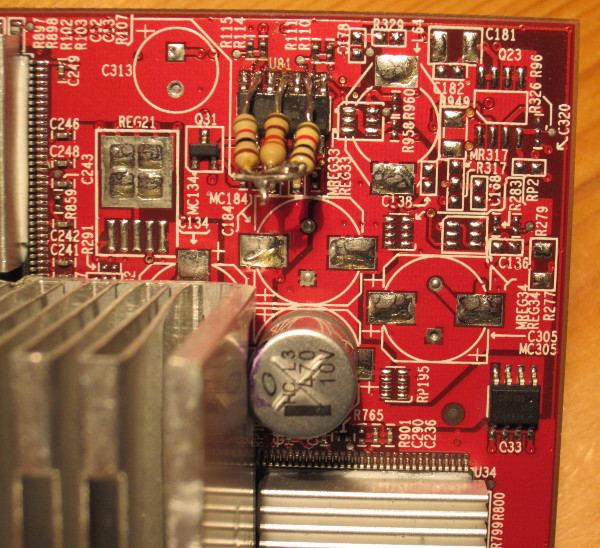 Not much to tell here, just a simple buck PWM regulator (ISL6522) with two MOSFETS to power the RV370. Just put a resistor or a trimmer on the FB and GND pin to increase the voltage. I ended up with 1.2kohms again to get 1.78V, which makes the RV370 very unstable if not cooled to room temperature. So if you want more stability i suggest 2.2k. 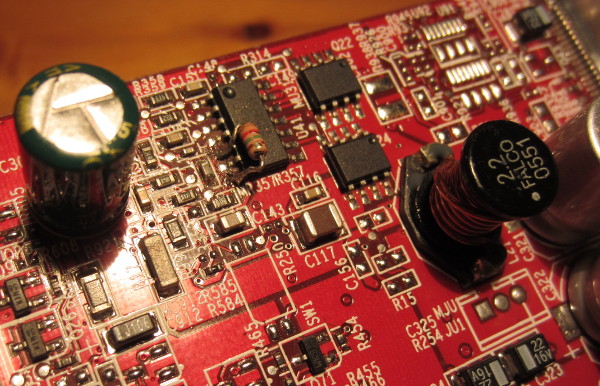 OverclockingSince i'm mostly working in a Linux environment i used rovclock to overclock the Dell Radeon. I then ran the title screen of Scorched3D to test stability. Usually it locks up any card within a minute or so if the speeds are set too high. I ended up with a speed of 620 for the core and 310 for the memory, cooled only by a quiet fan. That was sort of promising since i still had room for extra cooling (more air) and record cards did about 650 on hwbot. Hmmm, i wonder if this was one of those cards that could equal that... However it is not unusual in overclocking to have to resort to extreme measures in order to grab those last few clock cycles. So i downloaded the latest available driver from ATI for Windows XP and set up AtiTool to OC the card. The first run on 3DMark 2001 with the clocks on 620/310 mhz gave me somehwere about 18000 points. This was a lot lower than i'd hoped for, hmmm, what's going on here? I took a closer look at the drivers competitors were using and i noticed most use older drivers, that means they probably fiddled with the 3D settings as well.Increasing Stability To get more speed out of the card and break the 20000 barrier on 3DMark i figured the core was probably breaking under the increased stress from the voltage, heat and much higher clock rates. If i was able to stabilize the voltage a little and could get the heat away from the core faster it would probably do more. So i grabbed a broken CPU and took the heat spreader from it. Aluminium is a good conductor of heat, but copper is still far better. I put the heat spreader between the heatsink and the RV370, like cheese on a sandwich ;) Next the voltage stability, well i had an old dead motherboard with some nice caps that i took and soldered them to the back of the board on the pins of the existing caps. Like so: Lastly we needed more air to cool the card so that meant i needed the almighty AFB1212SHE from Delta once again. 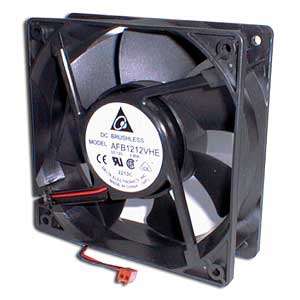 When it comes to pure CFM there's is no comparison, this thing is the absolute king. It comes at a price though because it devours 1.6 amps of power (almost 20 watts!) and produces a screaming 78 Decibels! This fan blows so much air it literally blows itself away, so you better grab some duct tape ;) With the new setup i was indeed able to run at higher speeds again, 630/315. This yielded the following score in 3DMark 2001: 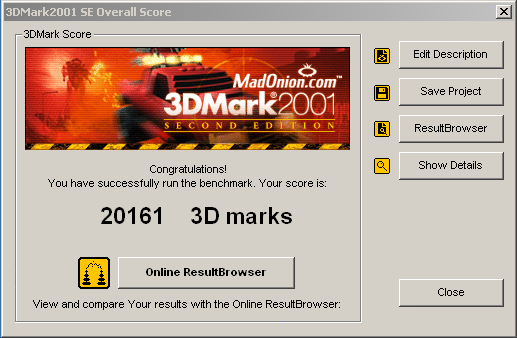 Yes! Broke the barrier. 'Engage computers. Prepare for warp speed' I even made it to 2nd place on HWBOT. Awesome! BIOS EditingWell it's nice to know our ancient beast can do magic but lets be honest here, i am not going to watch movies with 78Db's of fan noise blowing on a videocard. With a small fan running at an almost silent 5V i managed to get 600/300 completely stable without any glitches. And since i don't want to invoke an overclock tool every time i reboot the computer i decided to edit the card's bios too. For an older card like this we need RaBit, which you can get at Techpowerup. To retrieve your bios you can use Gpu-Z (click the icon in the Bios version line) or use Atiflash from a DOS bootdisk. 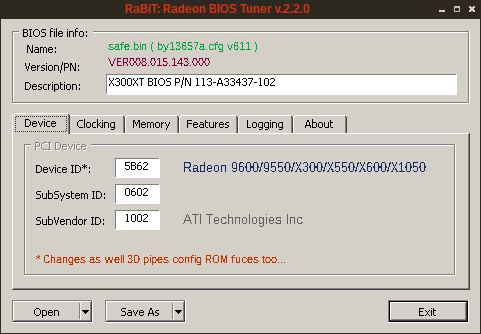 After editing the bios file with RaBit we'll need to create an USB bootdisk which you can easily do with Rufus, a utility that is normally used to convert ISO images to bootable USB pendrives. However the creator added a little bonus with a built in Freedos image! 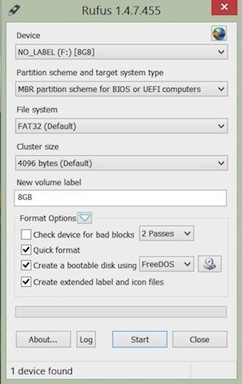 Then you will need to copy the proper Atiflash tool your usb drive to flash the bios. If you use the latest version it will just say the card cannot be found. I had success with Atiflash version 3.99 for this card. When you've booted with the USB drive use this command: atiflash -p 0 yourbios.binThe -p option tells Atitool to program and the 0 after it tells Atitool to program the first card. Do not enable any other (integrated) cards otherwise you must use Atitool to figure out which card number is the right one. My Radeon from hell is now running smoothly in a HTPC and doing a fine job rendering movies on the TV. Of course better solutions exist today and more efficient too, but then again those cost money and are nothing near as fun and educational as this one. The total modifications took about two evenings plus one extra to break the 20k mark in 3DMark 2001. If you're making an average buck that means you can buy a new videocard probably at the end of the week, but then again, is it faster? The cheapest card i could find today at about 30 dollars is a Geforce 210 with 1GB of 64-bit DDR3 memory and 590 mhz core clock. At stock speeds this card won't do a lot better as the overclocked Radeon i have here. Also the additional memory is of no use in a HTPC, but the built in VP4 decoder of the Geforce is. This will offload the CPU significantly so you are able to use an underpowered processor such as the Intel Atom. I do think there is a lot of hardware out there that can still be of use today, but is simply abandoned because of driver problems or false advise being given by noobs. So if you need more video power at a low budget i suggest looking at flea markets, ebay, craigs list, etc. I'll bet you'll find something much faster than a Geforce 210 for 30 bucks. How about a Geforce 9600GT? Bought that for a tenner this summer ;) Also for the record the radeon card is still officially supported in Windows 7 and with the bios mod i was able to raise the aero performance from 3.9 to 4.3, it actually feels that much faster too. |
Overclocking >